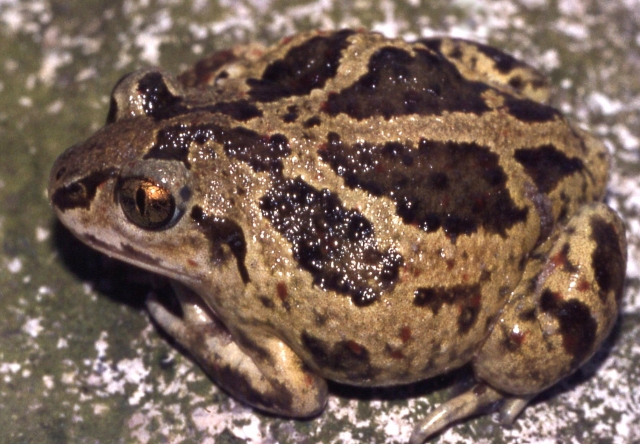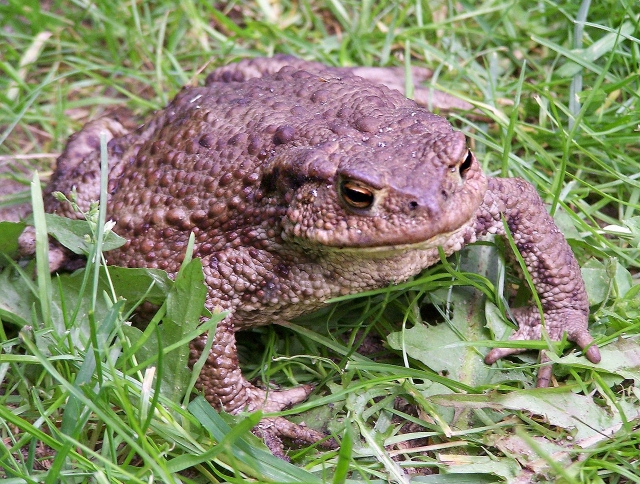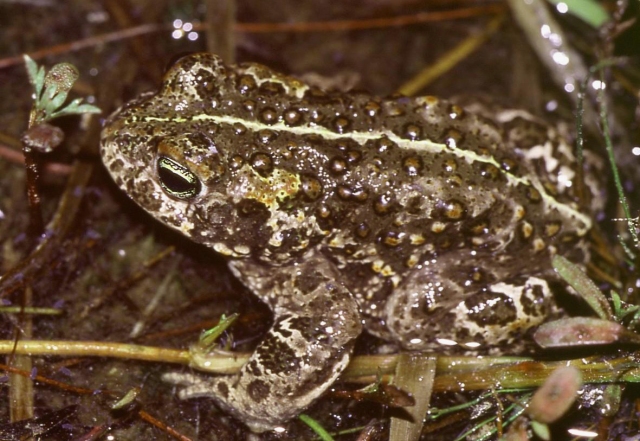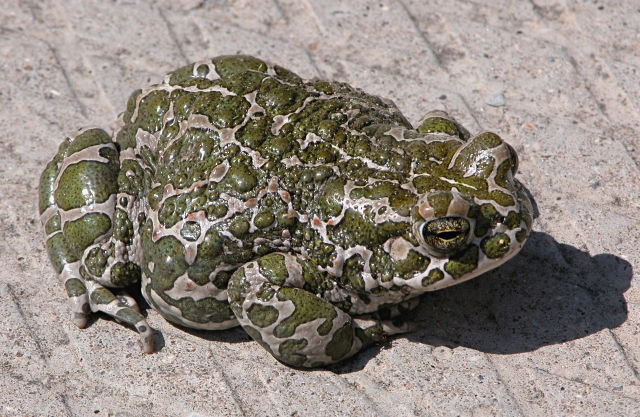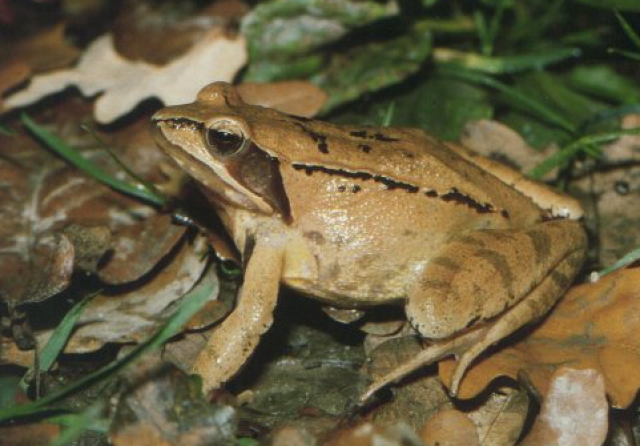Florian Heigl
European common spadefoot
Description
Adult males reach a maximum body length of 6.5 cm, females a maximum of about 8 cm; on average, however, both sexes remain slightly smaller. The coloration of the European spadefoot toad varies depending on the way of life, regional occurrence and sex. Mostly the animals show irregular dark brown, often elongated spots on a light gray to beige-brown ground. Almost every animal is thereby individually distinguishable. In addition, reddish or brown warts can appear, on the flanks also red spots. Females are usually more reddish brown in color, males tend to be more gray or clay yellow. In addition, the latter exhibit thickened upper arm glands at mating time. Some specimens lack the spotted pattern almost completely. While in the water, many individuals darken and thus have temporarily lower contrast markings.
The belly is whitish in color, often with light to dark gray speckles. Occasionally, albinotic forms also occur. Other distinctive external features are a helmet-like "parietal hump" on the back of the head and the vertical slit-shaped pupils, which are otherwise only found in the common midwife toad among Central European frogs. The metatarsal tubercle (callus internus) on the soles of the feet, which is present in all frogs, is particularly enlarged, sharp-edged and hardened in the spadefoot toad. It serves the animal as a "digging shovel" (digging callus).
The garlic odor, which gives this frog its name, is at most perceptible during a strong startle reaction. The secretion emitted serves as a defense against the predator. The behavioral repertoire of defense against predators is said to include active attacking and biting of the opponents as well as emitting a cry of fright similar to a toddler's scream. However, passive behaviors such as inflating the body or crouching are much more regularly observed in threatening situations.
Habitat
Adult toads are ground-dwelling terrestrial animals, except during the spawning season. They particularly prefer landscapes with loose, sandy to sandy-loamy topsoil (e.g. heaths, inland dunes, rough grasslands, steppes). Here, the animals can burrow quickly by means of their metatarsal tubercle " shovels" on the hind feet and the specially adapted leg musculature. The burrows dug are used several times by the animals. Under optimal environmental conditions, the subterranean daytime hiding places are literally turned into living caves, as the walls are mechanically stabilized and strengthened by the European spadefoot toad. In very dry summers, there may occasionally be prolonged periods of inactivity during which the toads rarely leave their burrow.
As soon as evening dusk falls, they dig themselves free from their underground hiding place to forage on the surface.
Agriculture and its tendency to increase acreage have benefited European spadefoot toads in some ways. The more open, tilled soil areas with loose grains are present, the more frequently the animals migrate into these habitats. European spadefoot toads are particularly fond of colonizing sandy potato and asparagus fields ("potato toad").
Small to medium-sized, eutrophic still waters such as ponds and pools with a minimum depth of about 30 cm are preferred as spawning biotopes. They also like to colonize so-called secondary biotopes such as gravel, sand or clay pits, but also extensively managed carp pond areas. A riparian zone rich in vegetation, for example overgrown with swath reed, cattail reed or flood lawn, meets the needs of the animals. More often, spawning sites are located near or even in the middle of cultivated farmland. For hibernation, European spadefoot toads burrow up to one meter deep into the ground. Found earth cavities, such as mouse holes or mole tunnels, are preferably accepted as winter habitats and remodeled according to their own needs. Topsoil in fens and floodplains is usually avoided by European spadefoot toads - unless the floodplain is interspersed with drifting sand dunes, geest islands or fluviatile sand deposits.
The text is a translation of an excerpt from Wikipedia (https://de.wikipedia.org/wiki/Knoblauchkröte). On wikipedia the text is available under a „Creative Commons Attribution/Share Alike“ licence. Status: 25 June 2021
European toad
Description
The body length of males in Central Europe is up to nine cm, females grow up to twelve cm long. Most adult European toads weight between 30 and 50 g (males) and between 50 and 100 g (females). The relatively plump animals have a stocky body, covered with warty skin glands on the upperpart, with a broad, short-nosed rounded head. On the back of the head there are prominent, paired, bean-shaped glands (parotids), which contain skin toxins to ward off predators. The upperparts are usually grayish to reddish brown; males are sometimes blackish brown or even light clay-colored, while females are more red. Washed-out dark spots may also be present, primarily in males. The underparts are dirty white in both sexes, with gray-black speckling throughout. The pupils are horizontally elliptical in shape, and the iris appears coppery to reddish gold ("amber"). European toads have rather short hind legs and move forward striding on all fours, but also hopping when disturbed. Males can also be identified at mating time by the brown to black nuptial pads on each of their three inner fingers. They also have stronger front legs, a flatter head, and remain smaller on average than females. Male European toads, unlike European green toads or natterjack toads, for example, do not possess vocal sacs.
Habitat
The European toad is a cold-blooded animal that is generally active at dusk. During the day, the animals rest under stones, crumbled walls, dead wood, foliage, shrubbery, or in burrows they have dug themselves. As terrestrial habitats, they colonize a wide spectrum of biotopes, ranging from forests to semi-open landscapes of meadows, pastures, and hedgerows to semi-natural gardens. Herb-rich forests (especially deciduous and mixed forests) without complete tree canopy closure are particularly preferred; settlement density is somewhat lower in closed upland forests. Floodplains are also not completely avoided, but are less favorable. Compared to other amphibian species, the European toad also occurs more frequently in alternately wet to dry forests. Orchard meadows and park-like landscapes are particularly popular because of the varied structures. The species is also found in drier habitats (e.g. vineyards, sand pits), but avoids very dry warm places.
Its occurrence in residential areas, parks, gardens, allotments, backyards, damp cellars, ruins and cemeteries justifies the designation "synanthropic species". Even in the midst of small towns, European toads can sometimes be found. Unsuitable habitats are, above all, intensively used farmland without field copses, vineyards that have been cleared of vegetation, and large-scale coniferous monocultures. The species also cannot exist where spawning waters are lacking over large areas.
Medium-sized to larger ponds, pools and lakes are mainly used as breeding waters. Still waters in or near the forest are colonized with great consistency. However, shallow and silting small water bodies are avoided by the European toad; a sufficiently large free body of water is a prerequisite for use as spawning habitat. The water depth should not be less than 50 cm; a weak flow is tolerated. Because of the inedibility of the larvae, the European Toad, unlike other amphibians, also spawns successfully in fish ponds.
The text is a translation of an excerpt from Wikipedia (https://de.wikipedia.org/wiki/Erdkröte). On wikipedia the text is available under a „Creative Commons Attribution/Share Alike“ licence. Status: 25 June 2021
Natterjack toad
Description
The size of males ranges from four to seven cm, females from five to eight cm. The back is marbled brown or olive on a lighter background. The skin surface is dry and warty. The large tubercles, as well as the parotids on the back of the head, are sometimes reddish in color. A thin longitudinal yellow line usually (but not always) runs across their "cross" (the back). The body is stocky, the head sloping sharply forward, the snout rounded, the pupil horizontally elliptical, the iris lemon yellow to greenish. The hind legs are also particularly short by toad standards, so natterjack toads rarely hop, but characteristically move forward in a mouse-like crawl.
Habitat
Like the European green toad, the natterjack toad is a pioneer species of warm, open habitats in areas with loose and sandy soils. The presence of vegetation-poor to -free biotopes with sufficient hiding places as terrestrial habitat as well as barely vegetated shallow and small waters as spawning sites is a prerequisite for the existence of the natterjack toad.
On the one hand, the preference for very shallow micro-waters for the deposition of the spawning cords involves the danger of drying out before the larvae have completed their metamorphosis. On the other hand, such habitats offer the advantage that they warm up very quickly and there are no predators in the water. The loud call of the natterjack toads is adapted to mating in annually changing waters - the female partner must be attracted not only to the male toad, but also to the corresponding unknown water body. Natterjack toads are found in excavation areas, inland dunes, post-mining landscapes, fallow land, construction sites, military training areas, coastal dunes, salt marshes and ruderal areas in human settlements. The species is sometimes found even in poorly structured agricultural landscapes, provided that suitable spawning habitats are available. The habitats mentioned are secondary biotopes. The natterjack toad is originally a species of floodplain landscapes, which have become very rare today due to straightening and damming of river courses and the construction of dams, where it finds optimal breeding conditions on open, dry-warm, mostly sandy sites.
The text is a translation of an excerpt from Wikipedia (https://de.wikipedia.org/wiki/Kreuzkröte). On wikipedia the text is available under a „Creative Commons Attribution/Share Alike“ licence. Status: 29 June 2021
European green toad
Description
The size of males ranges up to eight, females up to nine (ten) cm. While the basic color of the males is rather light gray, this is almost white in the females. Both are covered with green spots (more "washed out" in the male), which are missing only on the belly. On the flanks of the females are usually reddish warts. For the interpretation of the name "changeable toad" either the changing spot pattern is referred to or the ability of the animals to adapt their basic color from light to dark or vice versa depending on the environment. The pupils are horizontal and the iris is lemon-yellow to greenish. Like all Bufonidae, the species has ear glands (parotids) behind the eyes. There are many warts on the upperparts that are not very pronounced.
Habitat
As an eastern steppe species as well as a Mediterranean faunal element, the European green toad is well adapted to dryness and warmth. It prefers open, sun-exposed, dry-warm habitats with burrowable soils and sometimes lacking patchy grass and herbaceous vegetation. It is therefore found mainly in ruderal sites, in dry fallow land in fields, and in excavated areas. It sometimes moves very far away from open water. European green toads are mainly nocturnal. Spawning waters are shallow and poor in vegetation, for example in quarries. Temporary waters with mineral soil are preferred as spawning waters. The European green toad tolerates a slightly increased salinity of the spawning waters of more than ten per mille. Thus, the larvae are also able to develop in brackish ponds at the Baltic Sea. The ecological requirements of the species are similar to those of the natterjack toad, which has a more Atlantic or western distribution.
The text is a translation of an excerpt from Wikipedia (https://de.wikipedia.org/wiki/Wechselkröte). On wikipedia the text is available under a „Creative Commons Attribution/Share Alike“ licence. Status: 29 June 2021
European tree frog
Description
The snout-vent length of the European tree frog is 3 to 4.5 cm, in females also up to 5 cm. Body weight in the male can vary from 3.5 to 7 g, and in the female frog from 6 to 9 g, depending on the season. The head is wider than long; the sides of the head slope steeply, and the snout is correspondingly blunt-angled. The strongly protruding eyes have horizontal elliptical pupils, the sometimes dark speckled iris glows golden yellow. In the dark, the pupils dilate to fill almost the entire visible eyeball. The tympanic membrane is clearly visible and about half the size of the eye. Ear gland bulges (parotids), such as in the common toad, are absent. The front limbs are quite short and have four fingers each with adhesive discs (see below) at the ends, the hind feet have five toes each. The throat of males is yellow to yellow-brown in color and wrinkled, that of females whitish to light gray and slightly granular. Males have a large, yellowish or brownish, throat-shaped vocal sac.
skin, colouration
The skin surface is smooth and may be conspicuously shiny, especially when sunbathing. The upperparts are usually bright green in color. The belly and the inner surfaces of the extremities are predominantly white to light gray and granular. On both flanks, a dark stripe extends from the nostril over the tympanic membrane to the groin region. There it curves upwards and forms a so-called hip loop. Especially in the area of this hip loop, the flank stripe runs a bit differently in each individual. The hip loop is also called a groin loop, because the black lateral stripe ends in the groin region and does not form a loop.
European tree frogs can take on quite a varied color appearance in rapid succession. Variation ranges from light gray to yellowish to dark green.
Habitat
Depending on seasonal activity, tree frogs occupy very different aquatic and terrestrial subhabitats. The following habitat types and structures are relevant for a successful and sustainable life cycle:
aquatic subhabitats - Reproductive habitats
- FFish-free, sunlit small water bodies (pools, ponds, pressure/qualm water areas, bracks, flood depressions and oxbow lakes in river and stream floodplains, temporarily flooded grassland depressions, also water bodies in quarry pits).
- Vegetated, amphibious shallow and alternating water zones (as metamorphosis and maturation habitat for juvenile specimens).
- Aquatic and marsh plant communities of pondweeds (Potamogeton spec.), floodplain grasslands (especially Glyceria fluitans), acid grass fringes (sedges, rushes), and reed beds.
terrestrial habitats - daytime hiding places, feeding habitats
- Extensively managed wetlands and wet meadows as foraging habitat for growing and adult specimens.
- Wooded strips, reedbeds and watercourse-accompanying high herbaceous vegetation as perching and calling sites outside the mating season and as biotope network structures.
- Riparian forests, copses, moist coppice forests with plenty of sunlight, reed beds on sites close to groundwater.
As perching sites, adults and juveniles choose shrubs and even tree tops, especially various herbaceous plant species. In the literature, blackberry bushes are often mentioned; according to our own observations, the large leaves of burdock (Arctium spec.) are also particularly popular for sunbathing. However, it is not clear whether these structures are specifically preferred by the frogs or whether it is just easier to discover them on the large leaf surfaces.
The text is a translation of an excerpt from Wikipedia (https://de.wikipedia.org/wiki/Europäischer_Laubfrosch). On wikipedia the text is available under a „Creative Commons Attribution/Share Alike“ licence. Status: 29 June 2021
Moor frog
Description
This is a rather slender, delicate brown frog with a pointed snout. The pupils are horizontal, the tympanic membrane is clearly visible within the temporal patch, but quite small (size about 2/3 of the eye diameter) and far from the eye. The metatarsal tubercle is high arched and firm, unlike the sometimes similar looking European grass frog.
The snout-vent length of males and females ranges from 5 to 6, exceptionally up to 8 cm. The upperparts are light to dark brown, but there are also reddish-brown and heavily black-spotted animals. The typical brown frog temple spot behind the eye is dark brown. A broad, light longitudinal band often runs across the middle of the back, which is dark fringed, but this may also be absent. The glandular ridges on the back often have white edges and are distinct. The flanks are sometimes conspicuously marbled in black. The moor frog therefore appears comparatively vividly marked overall; the range of variation is individually very large. Only by combining several identification characteristics is it sometimes possible to distinguish them from other brown frog species. The ventral side is whitish and usually unspotted.
Habitat
The moor frog prefers habitats with high groundwater levels or periodic flood dynamics, especially fens, swampy extensive grassland, wet meadows and softwood floodplains of larger rivers, raised bogs and intermediate bogs. This is also where its spawning waters are located, which are characterised by sun exposure and partial weed coverage with sedge, rush and cotton grass fringes or floodplain grasslands. For hibernation, it visits woody biotopes, among other places.
The text is a translation of an excerpt from Wikipedia (https://de.wikipedia.org/wiki/Moorfrosch). On wikipedia the text is available under a „Creative Commons Attribution/Share Alike“ licence. Status: 29 June 2021
Agile frog
Description
Agile frogs are slender, long-limbed frogs with a pointed snout. The snout-vent length of males rarely exceeds 6.5 cm, that of females up to 9 cm. The upperparts are light brown, reddish brown or light greyish brown ("falllaubfarben") and comparatively poor in markings and contrast. The triangular temple patches with the tympanic membrane, typical for brown frogs, are dark brown. The underparts are whitish and usually completely unspotted. During the mating season, males in the water are often dark brown in colour. Dark transverse bands appear on the thighs and lower limbs, but these are not the only characteristic of the species. The hind limbs are remarkably long, which is why the animals are very agile: they can leap one to two metres. The pupils are horizontal; the iris is lighter golden in the upper third (above the pupil) than laterally and below the pupil. The tympanic membrane reaches about the size of the diameter of the eye and is located very close behind each eye. The glandular ridges on the back are not very pronounced and are interrupted in parts.
Habitat
The agile frog prefers light and water-rich mixed deciduous forests. It also inhabits the surrounding open countryside as long as it is connected to the forest by rows of shrubs. Forest pools, ponds, small ponds and ditches serve as spawning grounds. Fish-free waters with sunny shallow shore zones are ideal. The species often lives far away from water in rather dry-warm forests (coppice and middle forests). Of the three Central European brown frog species, it is the most heat-loving and the most drought-tolerant.
The text is a translation of an excerpt from Wikipedia (https://de.wikipedia.org/wiki/Springfrosch). On wikipedia the text is available under a „Creative Commons Attribution/Share Alike“ licence. Status: 29 June 2021
European grass frog
Description
The snout-vent length of adults reaches a maximum of eleven cm, with females growing slightly larger on average than males due to the slightly later onset of sexual maturity. Most specimens, however, are between seven and nine cm in size and appear quite plump. The upperparts can be yellow, red or dark brown in colour. In some animals it is only slightly marked, others have irregular black spots that can occasionally almost obscure the ground colour. The two dorsal gland bars approach each other a bit in the shoulder area. The characteristic triangular temporal spot on both sides with the tympanic membrane in it is distinctly dark brown, as in all brown frogs. The transverse striation of the hind legs is also a characteristic of all brown frogs. The male's underpart is whitish-grey and mostly unspotted, while the female's is often yellow with a reddish marbling. The tip of the snout is bluntly bevelled and rounded in plan view, the pupil is elongated and horizontally aligned. The inner metatarsal tubercle on the sole of the foot appears small and soft in this species.
The forelegs of the males are much more strongly built than those of the females. This is due to the reproductive behaviour, as the animals have to hold on to the females' backs in an axillary clasp (amplexus), sometimes for days. At spawning time, the males sometimes appear slightly "flabby" due to accumulations of lymph fluid and may even appear slightly bluish (but not as intensely as moor frog males). They develop dark, rough rutting calluses on their respective inner fingers during this phase. In females, a so-called breeding tubercles of whitish "spots" on the flanks and hind legs can be observed at spawning time.
Habitat
Spawning waters include a wide range of standing or slow-flowing waters. However, shallower, sunlit still waters such as small ponds and pools (also garden ponds) are preferred, although they are rarely allowed to dry out, or also cattle watering places in grassland areas. Floodplain grasslands, for example from the floodplain swath, are particularly popular as spawning substrates. After laying their eggs, the animals usually leave the watercourse very quickly and go over to terrestrial life. Habitats now include grassland, fringe biotopes, bushes, water banks, forests, gardens, parks and moors. At night, the frogs hunt for insects (e.g. beetles and grasshoppers), isopods, worms, spiders and slugs, during the day they hide in damp places between vegetation or under stones or deadwood. Hibernation sometimes takes place at the bottom of water bodies (then often collectively), but mainly terrestrially in holes in the ground and similar frost-free shelters. Before that, in autumn, the animals have usually already migrated some distance towards the spawning water or even use it for hibernation in cold torpor - summer habitat and hibernation quarters are therefore not necessarily identical.
The text is a translation of an excerpt from Wikipedia (https://de.wikipedia.org/wiki/Grasfrosch). On wikipedia the text is available under a „Creative Commons Attribution/Share Alike“ licence. Status: 29 June 2021
European green frog
Description
The snout-vent length ranges from 10 to 16 cm; specimens over 10 cm are mostly females. The upperparts are mostly olive green or olive brown, in Central Europe barely grass green, with distinct dark spots. The green dorsal midline typical of water frogs is usually present. The inner sides of the thighs are white-grey and black marbled (yellow parts are usually absent); the paired vocal sacs of the males are dark grey. The body structure is similar to that of its relatives, the pool frog and the common water frog, but with different proportions. The hind legs or lower legs are very long in relation to the torso. The metatarsal tubercle is small and flat.
Habitat
The European green frog has a very close relationship to water bodies. Even juveniles only move a few m away from the water. European green frogs prefer larger, eutrophic water bodies in the floodplain area, such as lakes, oxbow lakes, flood channels, calm river sections, larger ponds and quarry ponds, sometimes also canals and wide ditches. A rich aquatic and riparian vegetation is advantageous, but there should be no shading by woody plants. There, the animals like to sit on the shoreline and sunbathe. In case of danger or disturbance, they immediately jump into the water. Unlike most other frogs, they overwinter mainly aquatically in the water sediment. The species is therefore dependent on oxygen-rich waters that rarely freeze over completely or for long periods.
The text is a translation of an excerpt from Wikipedia (https://de.wikipedia.org/wiki/Seefrosch). On wikipedia the text is available under a „Creative Commons Attribution/Share Alike“ licence. Status: 29 June 2021
Pool frog
Description
The snout-vent length of the males is 4.5 to 5.5 cm - so they are only slightly larger than a European tree frog - the females are 5.5 to 6.5 cm long. The upperparts are predominantly grass-green in colour and speckled with rather regular black or brown spots. In addition, there is the typical water frog mid-dorsal line and reddish glandular ridges on the dorsal sides. Individuals with black-brownish colour pattern parts are also quite common, especially in female specimens. The iris is intensely yellow in males at mating time, as yellow body colours dominate at this time elsewhere; their vocal sacs are white. The lower legs are remarkably short in relation to the trunk; the metatarsal tubercle is large and semicircular.
Habitat
The pool frog is not as strictly bound to water bodies as its relatives, the common water frog and theEuropean green frog. Typical habitats in northern Germany are e.g. bog biotopes within wooded areas. Adults and juveniles often move far away from the water bodies. Preference is given to smaller, vegetated ponds, pools and ditches as well as marshes and bogs in their vicinity. The species is rarely found in large lakes and rivers. A closer connection seems to exist regionally - especially in the north of the distribution area - to boggy, mesotrophic habitats. Due to these requirements, the species is absent from certain habitats that are strongly influenced by anthropogenic activities.
The text is a translation of an excerpt from Wikipedia (https://de.wikipedia.org/wiki/Kleiner_Wasserfrosch). On wikipedia the text is available under a „Creative Commons Attribution/Share Alike“ licence. Status: 29 June 2021

